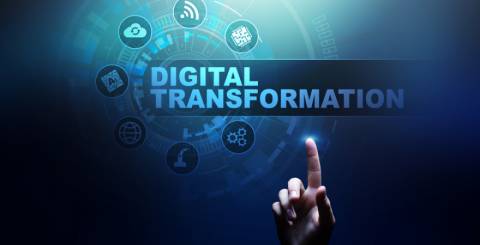Future of Digital Transformation

As always, the business is dead. Science fiction is becoming an increasing science fact. Digital transformation is more like a journey than a single leap from paper-based to digital technology and gaining digital competencies is an important part of the overall transformation strategy for companies on the path to digital innovation. A digital transformation strategy is an action plan aimed at consciously relocating an organization in the digital economy. Many organizations are transforming themselves and becoming more “digital”. A digital transformation plan like the McKinsey 7S digital transformation model is used to ensure that an organization is tuned in executing its strategy in a coordinated way.
Digital transformation is making a big difference in business processes and people, which are even more important than the technology itself. In other words, it's a broader business transformation. Digital transformation spaces are constantly changing at an alarming rate. Tracking trends and preparing for future change is critical to successful transformation. Currently business is experiencing unparalleled technological changes that are transforming every company in the world. This megatrend is called digital transformation.
1. Future Challenges of digital transformation
2. Future digital transformation uses all types of technology
3. Digital transformation change areas
4. Advantages of digital transformation
Future Challenges of digital transformation
Digital transformation has no ultimate goal. Everything is very dynamic and the goals change and evolve, so there is only a temporary end goal.it is better to take temporary end goal in mind and create a roadmap for the future.
Future Challenges of digital transformation will include
• How to transform the customer experience, Operational process and Business model, where should the company go? Who will lead the effort? How to "sell" the vision to key stakeholders, where should a company be in the digital ecosystem, how to make decisions during transformation, allocate funds quickly and dynamically, and what to do as the end goal of a digital transformation project always dynamic?
• How to Align with the virtual method to the company method and align skills, people, and alternate methods through virtual enablement?
• How to Create a plan like McKinsey 7S to broaden virtual management talents and verify management’s readiness for Implementing it?
• How to develop a brand-new company layout to embody the virtual lifestyle and verify new functionality wishes to broaden a virtual skills method?
• How to transition the personnel to the brand-new virtual company, align overall performance metrics, and plan to sustain?
• How to Alter organisational structure? Younger individuals of a company can be extra tech-savvy and apprehend era higher. However, the older extra senior individuals of a company have the higher commercial enterprise acumen.
• How to Think like a campaigner till the transformation
• How to maintain cooperation and coordination among crew silos and departments
• How to budget and useful resource allocation
• How to get the full backing of the management crew
• How to ensure regulatory and government compliance
The future digital transformation
The future digital transformation uses all types of technology. It is evolving at a pace that none of us has ever experienced. Tomorrow because of digital transformation, you will have positions like financial transformation consultants, SCM digital cloud transformation consultants, cloud consultants, digital security consultants, DevOps consultants, digital lean consultants and so on.
The digital transformation uses all types of technology to automate your business with Leadership development and Change management such as Cloud computing public cloud (45%) and Personal cloud (53%), ERP (Enterprise Resource Planning) software, CRM software (customer relationship management), HCM software (human capital management), SCM (Supply Chain Management) software, Business intelligence, Machine learning, Artificial intelligence, Predictive Analytics, Robotics, Industry 4.0, Internet of Things, Mobility and Cell technology (59%), Data Analytics/Massive information (58%) and APIs (40%), Data analysis, Digital security, and DevOps.
Digital transformation change areas
Research finds many digital transformations change areas including understanding customer wants and needs, increasing topliner revenues, opening new touchpoints for customers, automation of operations, knowledge sharing, performance management, digitizing parts of the business, creating new business models and Digital globalization. Virtual transformation is associated with people, approaches and technologies.
A Virtual Digital transformation roadmap of many companies consists of identifying your organization's ambitions based on where the value shifts, designing a transformation program for a profitable customer journey, making a difference through your partner ecosystem, reducing the risk of the transformation process to maximize the chances of success, improve techniques to boost up the virtual switch, update e-trade programmes and websites to lead them to a cellular-friendly environment, incorporate e-trade, cellular, web, social and carrier efforts to offer clients a clean experience, design a complete social media plan, redesign the complete customer support procedure to satisfy and ultimately exceed the expectancies of clients, allocate greater funding in IT and requirement of latest competencies.
The importance of digital transformation is felt when you aim at accelerated adoption, avoidance of costs, gaining an aggressive edge, improved efficiency, minimizing abilities shortage, defining ambition for the future and Mitigation of risks.
Advantages of digital transformation
Digitization improves efficiency through changing non-virtual procedures with virtual procedures or changing vintage virtual technology with new virtual technology. It also gives enterprises several advantages that include improving ordinary patron experience, leading to higher insights with the assistance of virtual analytics, encouraging departments to collaborate, improving innovation, pace and records protection and transparency, improving the information and skill set of employees, developing virtual leaders, rewire the company and increased people engagement and involvement.
Finally, beyond technology, we need to define true human value in this new digital ecosystem.
Similar Articles
Every business launch is exciting, but it also has its challenges, such as decision-making regarding the selection of proper tools for business processes. It is also a reality that today, no startup can lack software solutions when it comes to business organization and performance.
The education industry is not left behind by the new digital world shift. E-learning has received much consideration with the help of technological factors coupled with the ever-increasing demand for convenience and personalization
Managing a wide range of assets, from IT equipment to digital resources, can be overwhelming without the right tools. Businesses often struggle with asset mismanagement, leading to delays, unexpected costs, and compliance issues.
E-learning has become a quintessential wave through which learners access education in today’s te
Are you tired of keeping up with regulatory requirements and managing risk, which can feel like navigating a labyrinth? Organizations across industries face mounting pressure to maintain compliance while simultaneously driving growth and innovation.
Anyone even vaguely familiar with today's fast-paced digital world would know that e-commerce businesses face intense pressure. Pressure to deliver exceptional customer experiences while also maximizing their profits. To achieve this delicate balance, companies operating in this space must now put the power of technology to work
Intelligent technology-driven solutions are now guiding industries across all sectors. Innovative and disruptive technologies like Artificial Intelligence (AI) and Machine Learning (ML) are driving these changes, which play a crucial role in designing and developing intelligent solutions.
The introduction of Artificial intelligence (AI) healthcare has caused a radical change in the way that medical care is provided. It gains paramount importance when it comes to customised treatment regimens.
Graphical presentation of data and information in visual formats like charts, maps, and graphs is termed data visualization. This method makes complex data more accessible and easily understandable bringing out the trends and patterns from raw data, which can be used to significantly enhance customer experience









